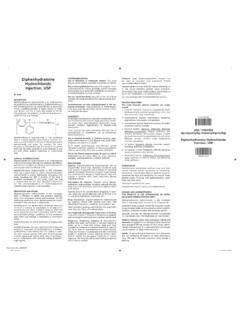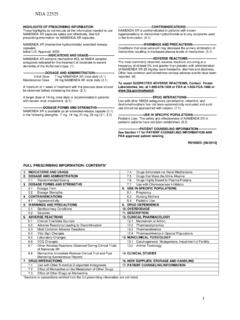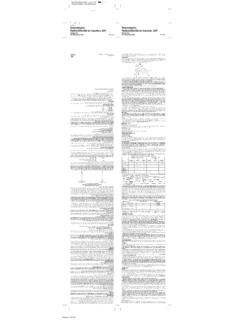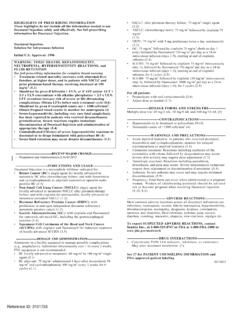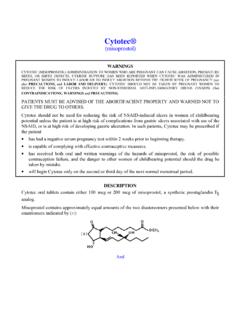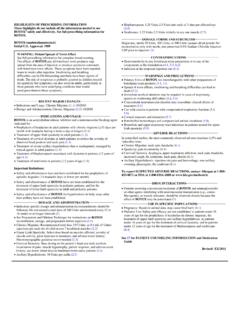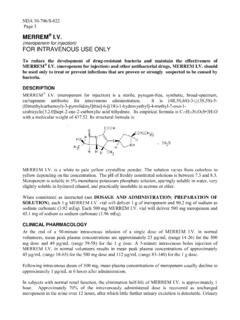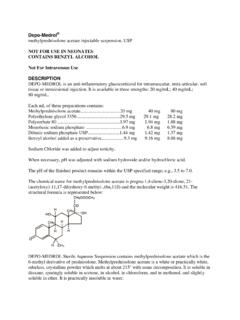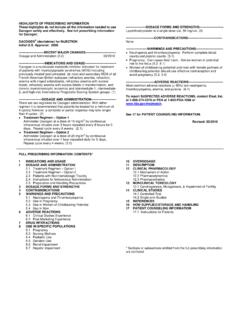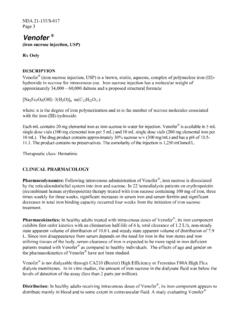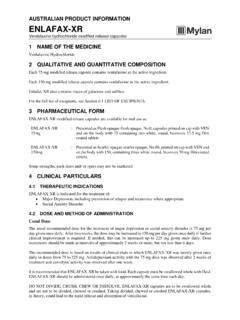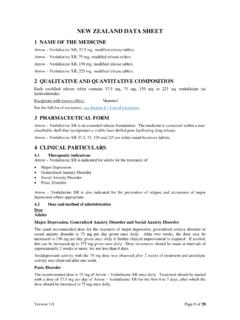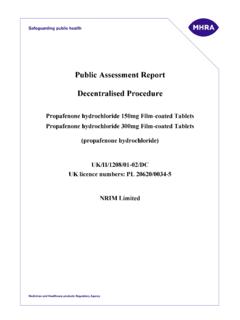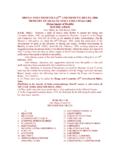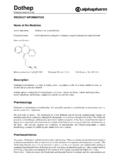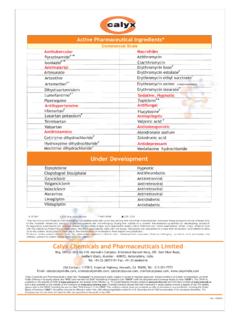Transcription of Effexor (venlafaxine hydrochloride) Tablets Suicidality ...
1 Effexor ( venlafaxine hydrochloride ) Tablets Rx only Suicidality and Antidepressant Drugs Antidepressants increased the risk compared to placebo of suicidal thinking and behavior ( Suicidality ) in children, adolescents, and young adults in short-term studies of Major Depressive Disorder (MDD) and other psychiatric disorders. Anyone considering the use of Effexor or any other antidepressant in a child, adolescent, or young adult must balance this risk with the clinical need. Short-term studies did not show an increase in the risk of Suicidality with antidepressants compared to placebo in adults beyond age 24; there was a reduction in risk with antidepressants compared to placebo in adults aged 65 and older.
2 Depression and certain other psychiatric disorders are themselves associated with increases in the risk of suicide. Patients of all ages who are started on antidepressant therapy should be monitored appropriately and observed closely for clinical worsening, Suicidality , or unusual changes in behavior. Families and caregivers should be advised of the need for close observation and communication with the prescriber. Effexor is not approved for use in pediatric patients. (See WARNINGS: Clinical Worsening and Suicide Risk, PRECAUTIONS: Information for Patients, and PRECAUTIONS: Pediatric Use) DESCRIPTION Effexor ( venlafaxine hydrochloride ) is a structurally novel antidepressant for oral administration.
3 It is designated (R/S)-1-[2-(dimethylamino)-1-(4-methoxyp henyl)ethyl] cyclohexanol hydrochloride or ( )-1-[ -[(dimethyl-amino)methyl]-p-methoxybenzy l] cyclohexanol hydrochloride and has the empirical formula of C17H27NO2 HCl. Its molecular weight is The structural formula is shown below. venlafaxine hydrochloride is a white to off-white crystalline solid with a solubility of 572 mg/mL in water (adjusted to ionic strength of M with sodium chloride). Its octanol: water ( M sodium chloride) partition coefficient is 1 Reference ID: 3229485 Compressed Tablets contain venlafaxine hydrochloride equivalent to 25 mg, mg, 50 mg, 75 mg, or 100 mg venlafaxine .
4 Inactive ingredients consist of cellulose, iron oxides, lactose, magnesium stearate, and sodium starch glycolate. CLINICAL PHARMACOLOGY Pharmacodynamics The mechanism of the antidepressant action of venlafaxine in humans is believed to be associated with its potentiation of neurotransmitter activity in the CNS. Preclinical studies have shown that venlafaxine and its active metabolite, O-desmethylvenlafaxine (ODV), are potent inhibitors of neuronal serotonin and norepinephrine reuptake and weak inhibitors of dopamine reuptake. venlafaxine and ODV have no significant affinity for muscarinic, histaminergic, or -1 adrenergic receptors in vitro. Pharmacologic activity at these receptors is hypothesized to be associated with the various anticholinergic, sedative, and cardiovascular effects seen with other psychotropic drugs.
5 venlafaxine and ODV do not possess monoamine oxidase (MAO) inhibitory activity. Pharmacokinetics venlafaxine is well absorbed and extensively metabolized in the liver. O-desmethylvenlafaxine (ODV) is the only major active metabolite. On the basis of mass balance studies, at least 92% of a single dose of venlafaxine is absorbed. Approximately 87% of a venlafaxine dose is recovered in the urine within 48 hours as either unchanged venlafaxine (5%), unconjugated ODV (29%), conjugated ODV (26%), or other minor inactive metabolites (27%). Renal elimination of venlafaxine and its metabolites is the primary route of excretion. The relative bioavailability of venlafaxine from a tablet was 100% when compared to an oral solution.
6 Food has no significant effect on the absorption of venlafaxine or on the formation of ODV. The degree of binding of venlafaxine to human plasma is 27% 2% at concentrations ranging from to 2215 ng/mL. The degree of ODV binding to human plasma is 30% 12% at concentrations ranging from 100 to 500 ng/mL. Protein-binding-induced drug interactions with venlafaxine are not expected. Steady-state concentrations of both venlafaxine and ODV in plasma were attained within 3 days of multiple-dose therapy. venlafaxine and ODV exhibited linear kinetics over the dose range of 75 to 450 mg total dose per day (administered on a q8h schedule). Plasma clearance, elimination half-life and steady-state volume of distribution were unaltered for both venlafaxine and ODV after multiple-dosing.
7 Mean SD steady-state plasma clearance of venlafaxine and ODV is and L/h/kg, respectively; elimination half-life is 5 2 and 11 2 hours, respectively; and steady-state volume of distribution is L/kg and L/kg, respectively. When equal daily doses of venlafaxine were administered as either or regimens, the drug exposure (AUC) and fluctuation in plasma levels of venlafaxine and ODV were comparable following both regimens. Age and Gender A pharmacokinetic analysis of 404 venlafaxine -treated patients from two studies involving both and regimens showed that dose-normalized trough plasma levels of either venlafaxine or ODV were unaltered due to age or gender differences.
8 Dosage adjustment based 2 Reference ID: 3229485 upon the age or gender of a patient is generally not necessary (see DOSAGE AND ADMINISTRATION). Liver Disease In 9 subjects with hepatic cirrhosis, the pharmacokinetic disposition of both venlafaxine and ODV was significantly altered after oral administration of venlafaxine . venlafaxine elimination half-life was prolonged by about 30%, and clearance decreased by about 50% in cirrhotic subjects compared to normal subjects. ODV elimination half-life was prolonged by about 60% and clearance decreased by about 30% in cirrhotic subjects compared to normal subjects. A large degree of intersubject variability was noted.
9 Three patients with more severe cirrhosis had a more substantial decrease in venlafaxine clearance (about 90%) compared to normal subjects. In a second study, venlafaxine was administered orally and intravenously in normal (n = 21) subjects, and in Child-Pugh A (n = 8) and Child-Pugh B (n = 11) subjects (mildly and moderately impaired, respectively). venlafaxine oral bioavailability was increased 2-3 fold, oral elimination half-life was approximately twice as long and oral clearance was reduced by more than half, compared to normal subjects. In hepatically impaired subjects, ODV oral elimination half-life was prolonged by about 40%, while oral clearance for ODV was similar to that for normal subjects.
10 A large degree of intersubject variability was noted. Dosage adjustment is necessary in these hepatically impaired patients (see DOSAGE AND ADMINISTRATION). Renal Disease In a renal impairment study, venlafaxine elimination half-life after oral administration was prolonged by about 50% and clearance was reduced by about 24% in renally impaired patients (GFR = 10-70 mL/min), compared to normal subjects. In dialysis patients, venlafaxine elimination half-life was prolonged by about 180% and clearance was reduced by about 57% compared to normal subjects. Similarly, ODV elimination half-life was prolonged by about 40% although clearance was unchanged in patients with renal impairment (GFR = 10-70 mL/min) compared to normal subjects.
